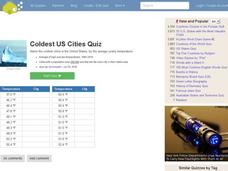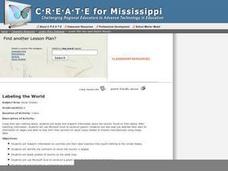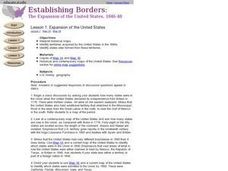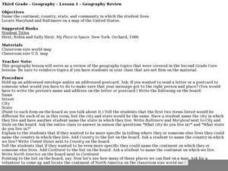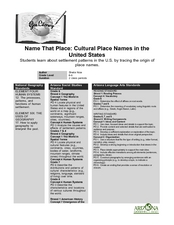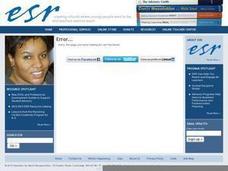Curated OER
Comparative Geography I
Students use population density and other statistics to compare countries. They find the population density for the countries listed in the table. Students compare findings with a partner, and then share with the class.
Curated OER
The Hunter Using Children's Literature to Teach the Geography of Africa
Students are able to answer basic questions about the region and the use of natural resources, sketch a mental map of the story's setting, and find their way through the thematic maze/map.
Curated OER
America's Heartland
Learners complete geography and trade activities about global trade. In this geography and trade lesson, students read information to learn about absolute advantage, comparative advantage, trade factors, U.S. trade partners, and...
Curated OER
Coldest US Cities Quiz
In this online interactive geography quiz worksheet, students respond to 20 identification questions about the coldest cities in the United States. Students have 4 minutes to complete the quiz.
Curated OER
Geological Forces and Topography
Learners discuss and research the Earth's geological processes. In this geology lesson, students study maps of Utah and the United States to learn about geological features. Learners then complete the research cards for each area of...
Curated OER
How the West Was One: A Layered Book
Students create a layered book about the information they learn about the Western region of the United States. In this Western states lesson plan, students create a book about the land, economy, and culture.
Curated OER
Weather Watchers
Students conduct Internet research of their community's weather and compare it to the weather in another location. After conducting research, students become weather reporters by reporting their findings to the class by using a...
Curated OER
The Cuban Missile Crisis of 1962
Sixth graders explain the importance the Cuban Missile Crisis of 1962 and the role it played in the Cold War. After studying the crisis, 6th graders compose an essay describing the crisis and how the U.S. became vulnerable to nuclear...
Curated OER
As Simple as Beans: Canada's Population
Students gather facts about Canada from various maps. In this Canada lesson, students use beans to relate the populations of the U.S. and Canada. Students create population distribution maps based on the placement of the beans.
Curated OER
USA Immigration by Country Quiz
In this online interactive geography quiz learning exercise, students respond to 30 identification questions about countries U.S. citizens have immigrated from. Students have 5 minutes to complete the quiz.
Curated OER
Labeling the World
Sixth graders conduct research on the countries found on the labels on their clothing. They locate the countries on a map, research the labor practices on countries that export clothing to the U.S., and create a graph using the information.
Curated OER
Do the Research!
In this research worksheet, students read 9 questions about different topics and do research to find the answers. Questions range from geography to popular trivia.
Curated OER
Monarch Migration
In this science and geography worksheet, pupils read a short passage about the migration pattern of the monarch butterfly. Students trace a path on the U.S. map showing the winter and spring migration.
Curated OER
To War or Not To War!
Ninth graders examine the various types of propaganda used during World War II. In groups, they make notes on each example and determine why they believe the opinion of the United States involvement in the war changed. They share their...
Curated OER
The Expansion of The United States, 1846-1848
Students interpret historical maps,identify territories acquired by the United States in the 1840s. Also they identify states later formed from these territories. The primary sources for the lesson are the maps found in the lesson's...
Curated OER
Little House in the Census: Almanzo and Laura Ingalls Wilder
How would you use census data from 1880-1900? Here are a set of ways you can incorporate the book Little House on the Prairie and US census data from that time period. Learners will research the validity or the book based on factual...
Curated OER
GEOGRAPHY OF FOOD & FIBER
Students will explain the ways geography determines the crops grown in the United States and other countries, and the resulting trade relationships.1. Discuss trade routes, both ancient and current. Discuss why the most direct route from...
Curated OER
Geography Review
Third graders name the continent, country, state, and community in which they live. They locate Maryland and Baltimore on a map of the United States.
Curated OER
Name That Place: Cultural Place Names in the United States
Students examine the origin of the people that settled in the United States. In this United States History lesson, students work in small groups to complete several activities that explore early settlement, such as a worksheet, a...
Curated OER
Madeleine Albright: First Lady of State
Students explore how Madeleine Albright made history by becoming the first female American secretary of state. This tough, talented and determined woman has had an unusual life that has well prepared her for her job.
Curated OER
Personality and Posts
Students examine the personality type needed to become a diplomat in the US Foreign Service. They look at the results of the Myers-Briggs Personality Test that each diplomat in training must take. They study their own personality type to...
Curated OER
Contemporary Afghanistan
High schoolers research the situational dynamics that have resulted in a civil war.
In small groups, they research the geography and culture of Afghanistan.
Groups analyze the political and cultural impact on people living in...
Curated OER
Presidents North and South Timeline
Fourth graders conduct online research to create a timeline of ten US Presidents. In this historical events activity, 4th graders find online information about the birth dates and birth states of ten US Presidents. This information is...
Curated OER
The Greatest Educational Change America Has Ever Seen
Young scholars connect the symbols from the design of the United States Mint Fifty State Quarters Program to our country's history in this five-lesson unit. The culture, unique heritage, and geography of the individual states are probed.



